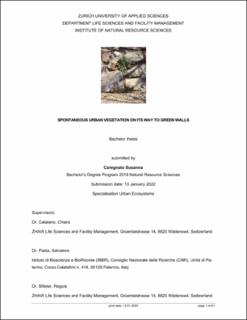Please use this identifier to cite or link to this item:
https://doi.org/10.21256/zhaw-25124| Publication type: | Bachelor thesis |
| Title: | Spontaneous urban vegetation on its way to green walls |
| Authors: | Caregnato, Susanna |
| Advisors / Reviewers: | Catalano, Chiara Pasta, Salvatore Billeter, Regula |
| DOI: | 10.21256/zhaw-25124 |
| Extent: | 81 |
| Issue Date: | 2022 |
| Publisher / Ed. Institution: | ZHAW Zürcher Hochschule für Angewandte Wissenschaften |
| Publisher / Ed. Institution: | Winterthur |
| Language: | English |
| Subjects: | Biodiversity; Urban vegetation; Wall vegetation; Green wall; Living wall; Biodiverse wall |
| Subject (DDC): | 333.7: Land, natural recreational areas |
| Abstract: | Allowing spontaneous urban vegetation to grow on building facades directly could represent a valuable alternative to current common green walls on building, from a cost and maintenance but also biodiversity perspective. The aim of this work is first to document characteristics of the sprouting points of plants on walls. Secondly, with the analysis of the recorded data, possible preferred structures shall be determined to be able to draw conclusions about germination and growth fostering design of construction elements for building facades. The work covers spontaneous vegetation growing on freestanding walls, retainment walls or walls of buildings and civil constructions in Zurich, Switzerland. The wall tops, vertical wall surfaces and wall base joints are assessed separately. With statistical methods (linear models) various environmental characteristics of the walls are examined for significant influence on species richness and cover or abundance. Further, quantitative evaluation of different characteristics of the sprouting Species cover on vertical wall surfaces is significantly positively influenced by inclination in interaction with distance from the ground of the plot and seldom maintenance. Plants use all different forms of sprouting points, i.e., joints, cracks, pores, the substantial difference in occurrence of plants in these different forms is mainly due their highly different occurrence on walls and not to a preference of the plants. Finally, water provision is the most critical point for successful facade vegetation on buildings. To realize a good water provision on facades for plants two options could be considered in future architectural designs of facades: 1. build facade with inclination over 10°; 2. Integrate rainwater flow and water retainment in the facade elements. |
| URI: | https://digitalcollection.zhaw.ch/handle/11475/25124 |
| License (according to publishing contract): | CC BY 4.0: Attribution 4.0 International |
| Departement: | Life Sciences and Facility Management |
| Appears in collections: | Bachelorarbeiten Umweltingenieurwesen |
Files in This Item:
| File | Description | Size | Format | |
|---|---|---|---|---|
| 2022_Caregnato_Susanna_BA_UI.pdf | 5.16 MB | Adobe PDF |  View/Open |
Show full item record
Caregnato, S. (2022). Spontaneous urban vegetation on its way to green walls [Bachelor’s thesis, ZHAW Zürcher Hochschule für Angewandte Wissenschaften]. https://doi.org/10.21256/zhaw-25124
Caregnato, S. (2022) Spontaneous urban vegetation on its way to green walls. Bachelor’s thesis. ZHAW Zürcher Hochschule für Angewandte Wissenschaften. Available at: https://doi.org/10.21256/zhaw-25124.
S. Caregnato, “Spontaneous urban vegetation on its way to green walls,” Bachelor’s thesis, ZHAW Zürcher Hochschule für Angewandte Wissenschaften, Winterthur, 2022. doi: 10.21256/zhaw-25124.
CAREGNATO, Susanna, 2022. Spontaneous urban vegetation on its way to green walls. Bachelor’s thesis. Winterthur: ZHAW Zürcher Hochschule für Angewandte Wissenschaften
Caregnato, Susanna. 2022. “Spontaneous Urban Vegetation on Its Way to Green Walls.” Bachelor’s thesis, Winterthur: ZHAW Zürcher Hochschule für Angewandte Wissenschaften. https://doi.org/10.21256/zhaw-25124.
Caregnato, Susanna. Spontaneous Urban Vegetation on Its Way to Green Walls. ZHAW Zürcher Hochschule für Angewandte Wissenschaften, 2022, https://doi.org/10.21256/zhaw-25124.
Items in DSpace are protected by copyright, with all rights reserved, unless otherwise indicated.